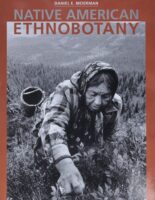Summer, 2003. This database has been online for many years. But this spring, with support from UM-Dearborn, it has been given a new look, and new functionality.
First, the new look will be obvious to anyone who has used it in the past. The photos, from top to bottom are Spring Beauty (Claytonia virginica), Cratageus sp. (Hawthorn),
Solomon’s seal (Polygonatum biflorum) growing under May Apple (Podophylum peltatum), Bloodroot (Sanguinaria canadensis), and a Poppy (Papaver somniferum).
Second, the new functionality comes from the linkage of most of the species in the book to the USDA Plants Database. If you search for, say, Sanguinaria, you will get a result like this (among many others):
Sanguinaria canadensis L. Bloodroot; Papaveraceae Algonquin Drug (Love Medicine) Used as a love charm and red dye for skin, clothing and weapons. Bradley, Will T. 1936 Medical Practices of the New England Aborigines. Journal of the American Pharmaceutical Association 25(2):138-147 (p. 142)
The difference from the past is that, if you click on the link, you will surf directly to the page for that plant at the USDA database where you can see a photograph of the plant, plus others like it, plus a broad range of botanical information on the plant. This works for most plants in the database except for a few mosses and alga, and for a few plants which occur only in Canada (out of the range of the USDA).
There are some other changes too. You no longer need to put in a number of items you wish to see. There is a limit of 500 to any one query, and the number shown is either the number in the query, or 500. If your query has more than 500 items, clever use of AND or OR can usually get the rest of the items for you. If you can’t get just what you want, feel free to contact me and I will help you.
A short history, in reverse order: This database is the result of a series of efforts over 25 years. A book based on the data base has been published by Timber Press, in Portland OR in 1998. To see the introductory material. sample pages, and reviews, look at Native American Ethnobotany. The list price of the book (which has 927 pages) is $79.95. As this is written, it is available at 30% off ($55.79) from Amazon.com . The book was given the Annual Book Award of the Council for Botanical and Herbarium Libraries in 2000. In 2002, the database had about 80,000 hits.

As noted, In the spring of 2003, substantial revisions of the database were made, revising its looks, and adding links to the US Department of Agriculture PLANTS database. This means that complete botanical information on useful plants, plus pictures, range maps, and endangered status, are immediately available.
The online database, and the book mentioned above, were largely completed in the late 1990s. The database now contains 44,691 items. This version added foods, drugs, dyes, fibers and other uses of plants (a total of over 44,000 items). This represents uses by 291 Native American groups of 4,029 species from 243 different plant families. About half of them are medicinal. This expansion of the database was supported by a grant from the National Science Foundation.
The second version of the database was published in 1986 by the Museum of Anthropology of the University of Michigan with the title Medicinal Plants of Native America. That database — which contained 17,634 items representing the medicinal uses of 2,147 species from 760 genera and 142 families by 123 different native American groups — was built over a period of about 10 years with support from the National Endowment for the Humanities, the National Science Foundation, and the University of Michigan-Dearborn. The data were entered using an elaborate scheme checking for data integrity which electronically resolved many botanical synonyms (which occur when the “same” plant gets different scientific names, something that often happens over long periods of time). The database is maintained on pcs in FoxPro format.
Beginning in the mid 1970s, the earliest parts of the database were built using punch-edge index cards. After about a thousand items were arranged that way, the system became very unwieldy and was transferred to a mainframe computer at the University of Michigan. The software used was one of the first database management systems called Taxir, written by Bob Brill. The first edition of the database was published in 1977 as American Medical Ethnobotany: A Reference Dictionary by Garland Publishing Company. It had 4869 items.

